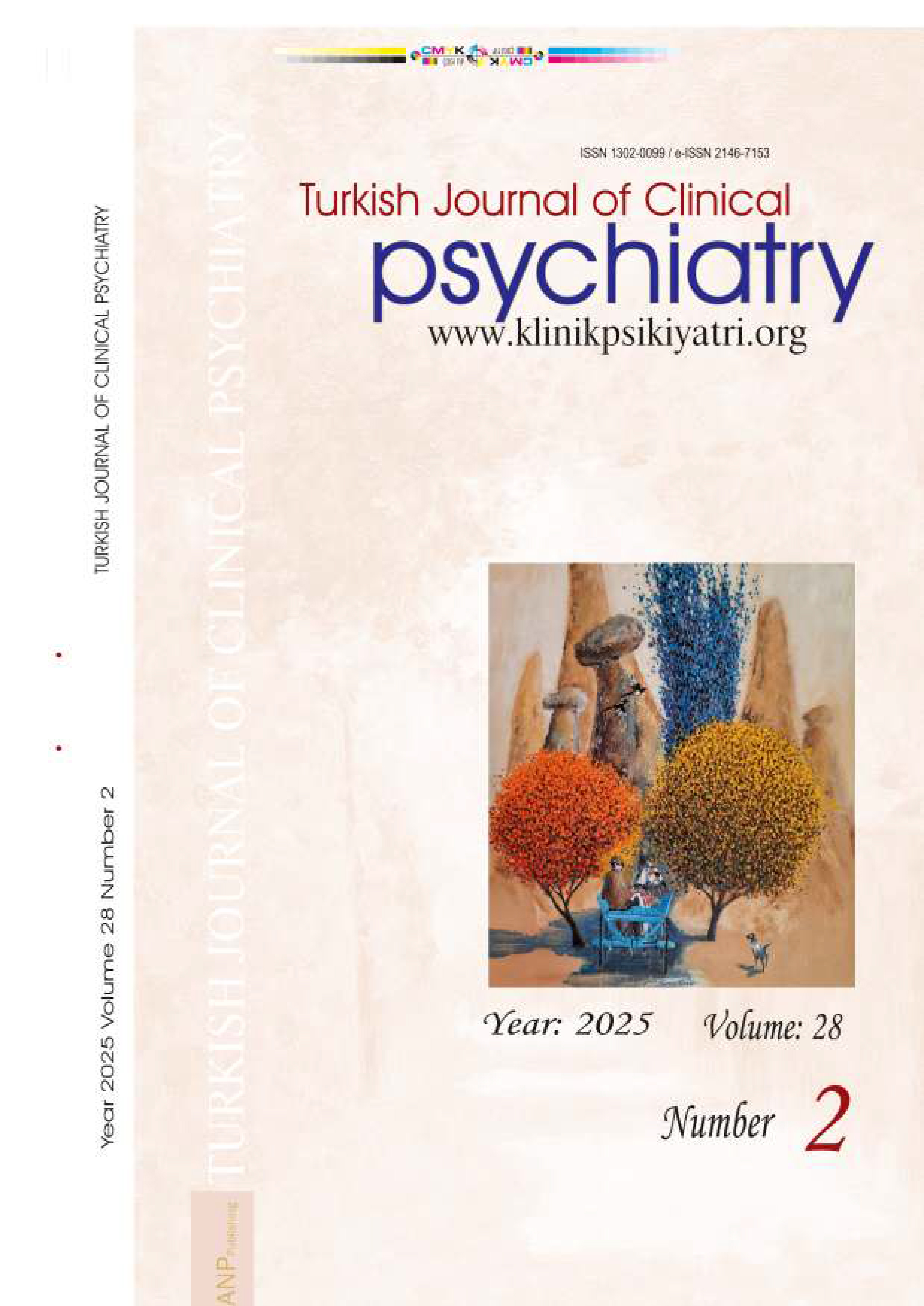





Volume: 16 Issue: 3 - 2013
| RESEARCH ARTICLE | |
| 1. | Validity and Reliability of Turkish Version of The Memory Functioning Questionnaire Selda Şahin, Nevzat Yüksel, Çisem Utku, Nurdan Eren Bodur, Özgün Karaer Karapıçak, Nurhak Çağatay Birer, Duygu Kaya Pages 135 - 147 Objectives: Subjective memory impairment (SMI) refers to conditions in which people complain of memory problems despite intact cognition. Subjective memory complaints (SMCs) are experienced by a large proportion of middle-aged and older adults, with some estimates being as high as 50%. One of the purposes of studying the relations between subjective cognitive complaints and neuropsychological tasks is to clarify the assertion that subjective cognitive complaints are a risk factor for dementia. Subjective cognitive failures are associated with lower hippocampal volume, even in subjects without objective cognitive impairment. Although some studies concluded that subjective memory complaints by healthy people were not in parallel with the results of objective neuropsychological tasks or were not early evidence of future cognitive deficits, some other studies concluded the opposite. The Memory Functioning Ouestionnaire (MFQ) has been used to investigate several major questions on the usefulness of assessing selfappraisals of memory functioning. The aim of this study is to investigate the validity and reliability of Memory Functioning Questionnaire developed by Gilewski et al. in 1990 that assesses memory perception in Turkish population. Method: The study group consisted of 112 healthy volunteers. The reliability of the MFQ was evaluated by testing its internal consistency and test-retest reliability. Results: Cronbach's alpha coefficient and intraclass correlation coefficients of the MFQwere 0.859 and 0.938, respectively. Conclusion: According to the present study the MFQ Turkish version showed to be valid and reliable. The questionnaire can be used for screening and follow up. |
| 2. | Prevalence of Pathological Internet Use Among High School Students: Kocaeli Sample Mehmet Şahin, Uğur Çakır, Emine Demirbaş Çakır, Aslıhan Özlem Polat Pages 148 - 156 Objectives: The aim of this study is to investigate the prevelance of pathological Internet use of high school students in Kocaeli and to test Turkish form of pathological Internet use scale (PIUS) with confirmatory factor analysis (CFA). Method: The study was designed in survey study model and 857students from different high schools constituted the sample group of the study which was determined by simple random sampling of probability sampling method. A sociodemographic form and pathological Internet use scale were used in order to collect data. Results: Results of the study were basically obtained in 4 phases. In the first phase, coefficient of internal consistency for reliability of Turkish form of PIUS was determined as (a 0.89). In the second phase, a nonnormal distribution in the scores of PIUS was determined (p< 0.001). In the third phase 9 (%1.1) high school students in the sample group were determined to be pathological Internet user. In the last phase male gender, feeling free, hiding identity during online and feeling regret after Internet use was determined to be associated with pathological Internet use. Conclusion: The findings of this study can guide academicians, educators, clinicians and researchers who study on preventing pathological Internet use. In addition these findings can be used in informing students, teachers and parents. |
| 3. | Psychiatric Comorbidity in Patients with Adult Enuresis Nocturna Şükrü Kumsar, Neslihan Akkişi Kumsar, Hasan Salih Sağlam, Osman Köse, Salih Budak, Öztuğ Adsan Pages 157 - 163 Objectives: Enuresis Nocturna is the most common urinary tract problem of childhood. Etiological factors had been researched and several theories are suggested. But study on adult nocturnal enuresis is limited. The aim of this study is to determine the frequency of psychiatric comorbidity in adult enuresis patients treated at the urology outpatient clinic and to investigate the its relation with social anxiety, and selfesteem levels. Method: Thirty-six adult enuretic patients are assessed with Structured Clinical Interview for DSM-IV Axis I Disorders (SCID-I), Hospital Anxiety Depression Scale (HADS), Rosenberg Self-Esteem Scale (RSES) and Liebowitz Social Anxiety Scale (LSAS). Control group included subjects matched to patients in terms of age, sex and education level. Results: In comparison to healthy controls, the rate of psychiatric morbidity is higher and mean selfesteem scores in the enuresis group are lower. There is also a significant difference between groups in terms of social anxiety. Liebowitz Social Anxiety scores are higher in the enuresis group. Conclusion: These findings suggest that the rate of psychiatric morbidity is higher in patients with enuresis than healthy control subjects. Adult patients with enuresis should be assessed in regard of mental disorders and psychiatric interventions may become necessary in the course of illness. |
| 4. | The Comparison of Parental Acceptance-Rejection and Psychological Adjustment of Children in Divorced and Married Families Nilgün Öngider Pages 164 - 174 Objectives: The aim of this study is to compare the parental acceptance-rejection and psychological adjustment of elementary school children which in divorced and married families. Method: The sample of the study consisted of 138 children from married families and 124 children from divorced families, adding up to a total of 262 respondents of those were sampled from an elementary school in City of Izmir. Parental Acceptance- Rejection Questionnaire (PARQ), Personality Assessment Questionnaire PAQ), and individual data questionnaire were administered to both of the groups of children. Results: Result of this study showed a high correlation between Mother PART and Father PART in married families' children group (r=.69); but there was no such correlation in divorced families' children group (r=.01). According to the findings of the study, in married families, there is a high correlation between psychological adjustment of chidren and Parental acceptance-rejection, both Mother PART (r=.63) and Father PART (r=.65). But in divorced families, there is a higher correlation between psychological adjustment of children and Mother PART (r=.55) then Father PART (r=.31). Conclusion: According to the findings of the study, in married families fathers are as important as mothers for the children's psychological adjustment; whereas in divorced families the effects of fathers on children become less and mothers have a greater impact on their children's psychological well being. These findings are interpreted as the negative effect of divorce on father- child relationship. The results of our study are consistent with the literature. |
| REVIEW | |
| 5. | Comorbidity of Eating Disorders and Bipolar Disorder Asena Akdemir, Bahar Sarı Narğis Pages 175 - 180 Eating disorders are common disorders especially in young women. Food restriction, binge eating, vomiting, purging are diagnostic features of the disorder. The prevalence in young women is reported as %0.3 for Anorexia Nervosa and as %1 for Bulimia Nervosa while it reaches to %5-10 if obesity is included to the clinic. Eating disorders are common in bipolar patients so that the clinicians should be careful while treating these disorders. The prevalence rate is reported as %1-5 in bipolar spectrum disorders. Depressive symptoms that may be seen in both disorders led studies about comorbidity. Authors investigating the lifetime comorbidity of eating disorders in patients with BD and comorbidity of BD in patients with eating disorders in community surveys and in clinical studies showed that comorbidity of these disorders is high. Most of these studies include subtreshold clinical cases and all spectrum symptamotology. Bulimic behaviors, impulsivity and affective disorders may be due to serotonergic neurotransmission disorder as a result of genetic vulnerability or early life trauma. Pharmacologic treatment approaches to patients with BD and a comorbid eating disorder require examination of the possible adverse effects of the treatment of each syndrome on the other. Both disorders may be managed with agents that might be beneficial to each at the same time. Use of mood stabilizers alone or as adjunct to serotonergic agents may be beneficial in some of the cases. This may be due to the similar pathophysiological mechanisms of both of the disorders. |
| CASE REPORT | |
| 6. | Parkinsonism Developed by Paliperidon Usage: A Case Report Musa Şahpolat, Önder Kavakçı, Nesim Kuğu Pages 181 - 184 Typical antipsychotic medications are used to treat schizophrenia since 1950s.These drugs may cause side effects over extrapyramidal system (EPS) such as hyperprolactinemia, worsening of negative symptoms and dystonia, parkinsonism, akathisia and tardive dyskinesia by blocking dopamine (D2) receptors. In recent years, atypical antipsychotics managing D2 and 5HT2A receptor blockage with fewer extrapyramidal side effects compared to typical antipsychotics have been developed and their use has progressively increased. Antipsychotic- induced Parkinsonism is also called as "pseudo- Parkinsonism" and starts with symptoms such as muscle stiffness, foot-walking, drop, mask face, weight loss and difficulty in getting up from the seat. In studies regarding the use of atypical antipsychotics, atypicals have been shown to have lower risk profile versus typical antipsychotics on development of drug-induced Parkinsonism. Paliperidone is an atypical antipsychotic obtained by combining 9-hydroxy risperidone,which is an active metabolite of risperidone, with oral administration technology of osmotic controlled release systems (OROS). Paliperidone is a D2 and 5HT2A receptor antagonist, which is active by central path, and also has antagonist effects on alphal and alpha2-adrenergic and histamine HI receptors. There is no significant difference from placebo especially at lower doses than 9 mg / day in terms of extrapyramidal side effects. In this case report, a patient who was followed with diagnosis of schizophrenia is presented. After six days of paliperidone treatment (6 mg/day), the patient developed parkinsonism. |
| 7. | Angioedema Associated with Addition of Risperidone to Antidepressant Treatment: A Case Report Nalan Kara Pages 185 - 190 Angioedema is an edema of the skin and subcutaneous tissues. The exact mechanism of medication induced angioedema is not known well. Pro-inflammatory modulators, especially IgE-related type-1 hypersensitivity reactions are thought to cause angioedema. Medication- induced angioedema can be classified as angioedema with / without urticaria or allergic / non-allergic angioedema. Allergic angioedema is related with immünglobülin E. Non-allergic angioedema can be seen as hereditary, acquired, renin-angiotensin-aldosteron system (RAAS) blockers related, pseudoallergic or ido- pathic. Cases of angioedema induced by venlafaxine, mirtazapine and risperidon were reported in the literature. In our case, a 41 years old, married female patient with depressive symptoms was brought to psychiatry outpatient unit. The patient had been on 20 mg/day fluoxetine and 30 mg/day mirtazapine for 2 months. Fluoxetine had been stopped for it was thought to be ineffective. Venlafaxine 75 mg/day was added to mirtazapine as combination treatment and risperidone was given 0.5 mg /day for agitation. We stopped risperidone immediately after the occurrence of angioedeme and angioedema disappeared consequently. Angioedema was thougth to be related with addition of risperidone to antidepressant treatment. Angioedema was not shown to be associated with any systemic signs such as hypotension, serum IgE level was normal and no urticaria was detected at the time of angioedema. As a result it was considered to be a non-allergic angioedema. Clinicians may encounter with angioedema due to psychotropic drugs and it may have fatal results. Due to these findings clinicians should prescribe multiple medications with caution, especially in cases with history of allergy. |










